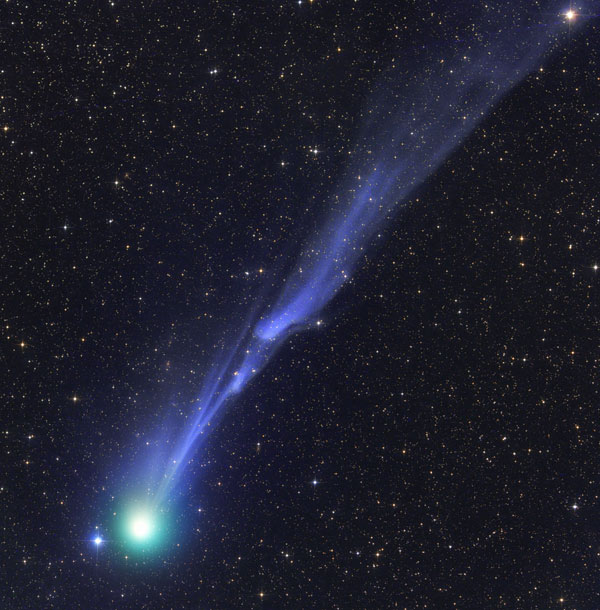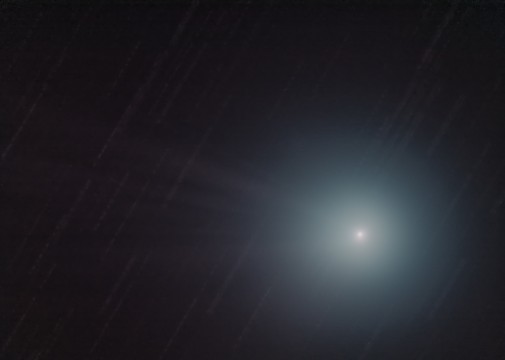It's still hanging in! Comet Lovejoy is fading more slowly than expected, still at 6th magnitude, and the Moon is gone from the evening sky.

It's long past perihelion and it's also receding from Earth, but Comet Lovejoy, C/2014 Q2, remains a target for telescopes and largish binoculars for early-evening observers. It's now high in the northwest after nightfall, coasting northward day by day across Cassiopeia. Look early before it sinks low.

As of March 11th the comet was holding at about magnitude 5.8, fading more slowly than predicted. See various observers' recent brightness observations; look for "2014 Q2."
Moonless early evenings continue through about March 24th. During this time Lovejoy crossed the W pattern of Cassiopeia, probably fading to 6th or 7th magnitude: still within good telescopic reach.
During the moonless nights of April (about the 7th to 23rd), it may be magnitude 7 to 9. The comet passes very close by Polaris in late May, when it was originally predicted to be a mere 12th magnitude, but the way things are going, it could be less faint and still within small-telescope reach.
For more on this comet, see our previous Lovejoy story.

For more to see with your binoculars, check out Gary Seronik's Binocular Highlights.
And if you're not getting Sky & Telescope magazine, what are you waiting for??
 2
2









Comments
Anthony Barreiro
February 19, 2015 at 2:51 pm
It has been such a treat to follow this comet with binoculars for almost two months, to be able to see it high overhead from my urban back yard, and to show the comet to passersby in a nearby hilltop park. A couple of weeks ago I could tell that the comet looked slightly asymmetrical and a little brighter toward the western edge. The comet now looks smaller and is definitely getting fainter, but still obviously fuzzy. I plan to wave goodbye as the comet heads north toward Polaris. I won't be around for its next visit in 8000 years. I wonder if there will still be a human civilization to recognize and welcome back Comet Lovejoy C/2014 Q2.
You must be logged in to post a comment.
February 22, 2015 at 12:39 am
Caught the comet Thursday night, February nineteenth, from the soon-to-be Palo Pinto Mountains State Park a couple of miles west of Strawn in northern central Texas, about 100 miles west of the astronomically-wretched Dallas-Fort-Worth area. Couldn't see it unaided ~20º above the NW horizon but found it easily with binoculars on a clear night - a greenish fuzz-ball with a tiny bright core, a little below the main clutch of Perseus's stars. Perhaps it's not the most spectacular sight, cometarily speaking, on account of its lack of an easily-discernible tail but it's interesting to see and contemplate the amount of celestial real-estate it's covered since I first caught it in late December, on Christmas Eve, and it provides a good spark to learn more about comets generally.
With the weather deteriorating over the next few days and the moon reaching first quarter by the middle of next week, my star-gazing here will be on its usual hiatus for the next two-and-a-half weeks at least, given that I prefer the sky's fainter sights, but I'll be heading back to Strawn or someplace similar shortly thereafter to check in on Comet Lovejoy once again.
You must be logged in to post a comment.
You must be logged in to post a comment.